- Ask a Beer Pro: How Do I Know if My Beer Was Poured From a Dirty Draft Line?
- The VinePair Podcast: Can Alcohol Benefit From Cannabis Going Bust at the Ballot Box?
- The Cocktail College Podcast: Techniques: Bitters (Re-Run)
- Guest to Impress With These 3 Holiday Wine Selections
- A ‘challenging yet surprising’ vintage for Centre-Loire in 2024
- The Trade Up: How Rémy V Upgrades Any Cocktail
This week, I had a chance to check out the Alentejo wine region in Portugal. It’s one of the biggest wine-producing areas in the country, known for its indigenous wines and scenic landscapes. Master Sommelier Evan Goldstein led us through a session explaining the region and tasting the wines.
Located in the southern part of Portugal, Alentejo covers about one-third of the country. The region is characterized by vast plains, hills, and a Mediterranean climate, creating favorable conditions for grape cultivation. Portugal is the fourth-largest wine region in Europe and the eighth-largest wine region in the world.
Evan talked about the “six A’s of Alentejo” as a broad overview:
Alicante Bouschet — the pride of Alentejo and the region’s flagship red. Antão Vaz — an indigenous and delicious white grape variety from Alentejo. The classic red blends of Alentejo — winemakers have almost 250 varieties to work with, so they are known for their playful take on blending skills. Amphora/talha (as referred to in Alentejo) winemaking — aside from the Republic of Georgia, Alentejo is the only region with a continued tradition of amphora winemaking dating back over 2,000 years. Activism — Wines of Alentejo’s internationally recognized Sustainability Program (WASP) have established the region among the world’s most progressive where sustainable winemaking is concerned. Altitude — wines from Portalegre in the northernmost part of Alentejo, as well as the higher elevations of Vidigueira to the south.
The Story Behind the Story of
This Article was originally published on Dallas Wine Chick






